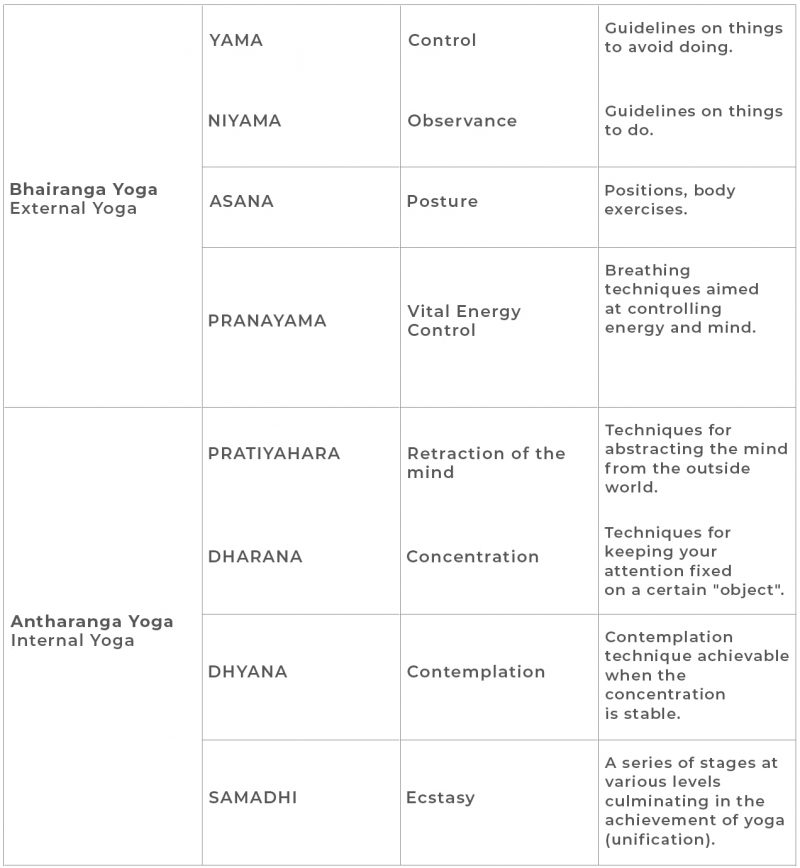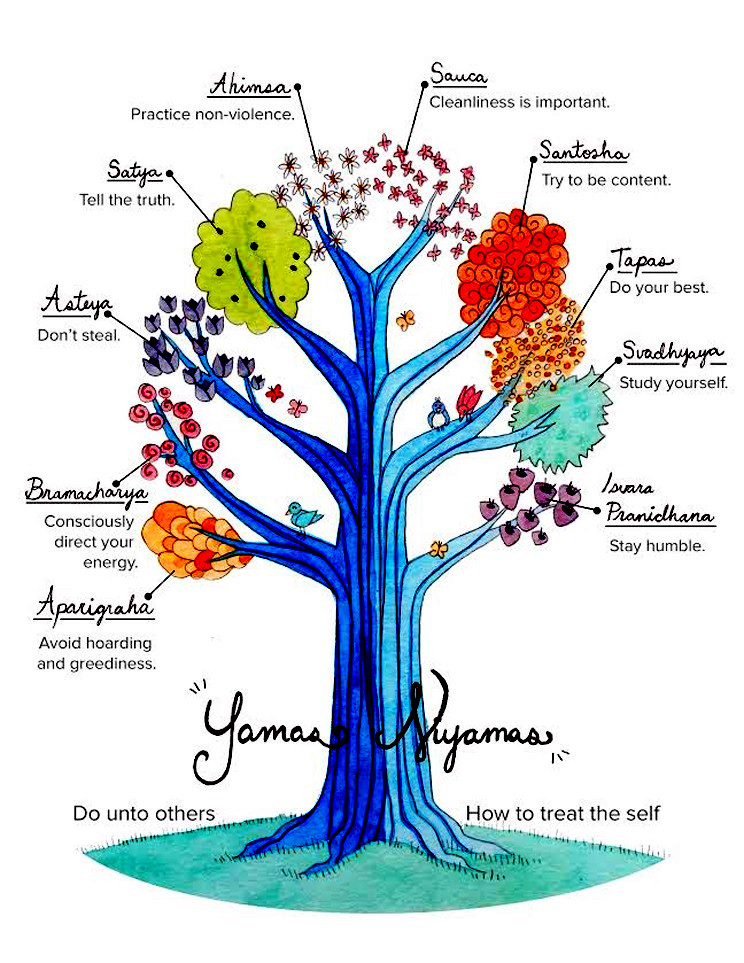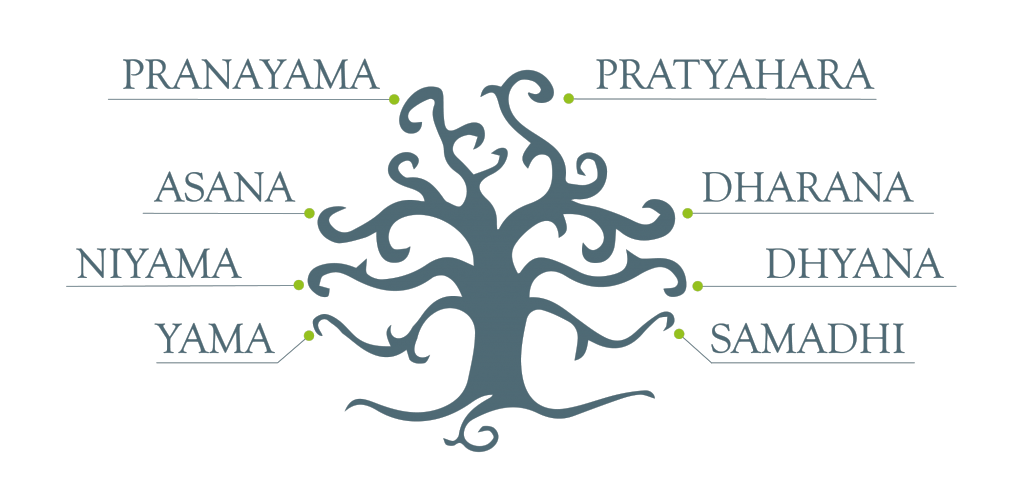
The concept of Yoga was born in the cultural context of Tantra, the ancient and original culture of India. The term “yoga” can be translated with the word “unify”, and more precisely it refers to the union of individual and cosmic consciousness.
The stage in which individual consciousness expands to reach the amplitude of Cosmic Consciousness (Sanskrit Brahman) is called Yoga.
In the Indian culture of Tantra, the system of practices developed to bring man to the “state of Yoga” is known as Ashtanga Yoga, the “eight limbs” Yoga. This system includes all the activities related to Yoga which, if practiced in an integral way, lead to the development of a lifestyle that induces the evolution of the individual and the environment in which he lives.
Ashtanga Yoga is structured like this:

The first two branches of this system are a series of guidelines that the yogi assumes as rules of life, prerequisites for obtaining valid results from the practice of Yoga; as we will see, these are suggestions for living so that our conscience is always in place both with ourselves and with others and with the surrounding environment.
In ancient times aspirants to Yoga had to observe these principles for a long period of time before they could be instructed by their Spiritual Master (Guru) in the most advanced practices.
Settling in the constant practice of these guidelines requires time and a deep understanding of their meaning, as well as the ability to put them into practice in the dense everyday life with all the nuances it entails.
YAMA: things not to do to live in harmony with the rest of the world.
1. Ahimsa – Non-violence: avoiding giving in to violence is the basic requirement for living in harmony with the surrounding environment, and here we mean both physically and mentally and also towards all forms of life. Ahimsa requires deep reflection to be understood correctly, aggression is a natural function of living beings, it is necessary to distinguish between its healthy and unhealthy expressions.
2. Satya – Truthfulness, honesty: a yogi seeks, first of all, the hidden truth of existence and therefore will commit himself to practicing the truth even when he expresses himself. However, Satya is the benevolent truth and this means that we must be careful not to hurt anyone with our words even when we are in the “real”. In some cases, omitting to say something, even if true, can avoid unnecessary suffering to our fellowmen. Here, too, it is important to reflect on this principle and how to apply it in our life.
3. Asteya – Abstention from theft. Taking what does not belong to us, but also not giving others what is due to them, is what we commonly call “theft”. The yogi absolutely avoids violating the rights of others and therefore refrains from appropriating things that do not belong to him, taking care to monitor his mind to verify that he unconsciously takes advantage of situations that go against this principle.
4. Bramacharya – Seeing everything as part of Brahman. This is a delicate point to understand because it is often translated as “celibacy”. In reality it is a mental attitude that corresponds to seeing all the things around us as the expression of a Whole and therefore with respect, with love. In the tantric tradition brahmacharya is concretized in a meditation practice called madhu vidya. For those who decide to take practices to a high level and perhaps choose a monastic life, this guideline is transformed into the practice of celibacy.
5. Aparigraha – Refrain from wanting superfluous things. Practicing Yoga inevitably leads to make one’s life richer internally and, as this happens, the practitioner realizes that the more things he possesses the more his existence becomes complicated forcing him to give up contact with a state of peace and inner serenity for take care of administering his possessions with all the worries and responsibilities they entail. Giving up superfluous things therefore makes the mind freer, life easier and contact with oneself deeper. Those who get used to this way of life are generally more serene.

NIYAMA: things to do to live in harmony with yourself.
1. Shaoca – Physical and mental hygiene. The yogi takes into consideration the aspect of hygiene both physically and mentally: physically hygiene is treated by keeping the body clean externally using natural detergents, and internally following the right diet and fasting periodically. On the mental plane, he keeps his mind internally clean with a positive and constructive attitude of thought, externally preventing negative stimuli from penetrating into the subconscious, therefore carefully choosing the things he is interested in or passionate about.
2. Santosa – Be satisfied, peaceful attitude. Often life does not take place exactly as we would like, indeed often events do not follow the desired course and this causes disappointment, dissatisfaction, anger, etc., the right attitude would be to welcome events without reacting negatively, to be content with what life passes without expecting things in a precise way. This is certainly difficult, but the practice of Yoga in an integral way concretely develops the ability to remain calm in the face of situations even when we don’t like them and to know how to enjoy the things we already have!
3. Tapah – Sacrifice, service and altruistic sense. Putting our resources and abilities at the service of others or a just cause by sacrificing part of our energies and our time is indicated by yoga as one of the best ways to experience a sense of profound union with the Whole. Volunteering leads us to feel that our life is good for those around us and in turn makes us feel profound happiness. It is wonderful to see the people around us who smile and are well! But one must be careful not to find oneself doing good to others just because one is convinced that it is right to do it … it could bring opposite results and increase one’s ego. The desire to practice tapah arises spontaneously when the heart opens thanks to meditation.
4. Svadhyaya – Study, introspection. This point has two aspects, one related to the study of the philosophy of life, the deepening of the meaning of life, the reading of texts related to Yoga (or sciences that have dealt with revealing the deep and hidden nature of life), to the deepening of practices also on a theoretical level, etc. The other linked to introspection, to the study of oneself, to the search for those conditions inherited from society, from the family, from education that do not allow us to be completely ourselves.
5. Iswarapranidhana – Abandonment to the Supreme. In the tradition of Tantra and therefore of Yoga, this point finds a concrete realization in the practice of meditation on the first level. The concept of “abandonment” is often difficult for us Westerners to understand. It is a matter of freeing oneself from attachment to one’s ego, of identification with one’s subjective, individualistic reality and embracing a higher level of existence, or at least a higher way of conceiving it. By practicing meditation, you develop the ability to “surrender” to the supreme entity that regulates the life of the entire universe to let itself be guided by the force of its nature.
We can therefore say that these guidelines constitute the yogi’s “Code of Ethics and Morals”. The concept of morality in Tantra is based on respect for the laws of nature and has the purpose of leading to freedom from the bonds of material illusions (maya) and ignorance (not knowledge of the true nature of existence) which are the cause of great part of our suffering. When we start practicing Yoga it is necessary to put our body and our mind in the ideal conditions to reach the deepest dimensions of the spirit, the purpose of Yama and Niyama is precisely to eliminate all the psychic and emotional disorders caused by hatred, violence, dishonesty, greed and so on.

ASANA: Posture. The third limb of Ashtanga Yoga consists of the exercises and positions of Yoga. Again, care must be taken not to confuse these positions with common gymnastic exercises; Yoga positions, in fact, acting directly on the endocrine system of the human body, promote a real psycho-physical transformation by elevating the general state of health of the individual who can thus dedicate himself serenely to the most advanced meditative practices.
PRANAYAMA: Vital energy control. The fourth limb of Yoga leads to the control of vital energy through increasingly complex breathing techniques. These techniques must be learned and practiced under the guidance of a qualified teacher, as they involve some risks if done incorrectly, or at the wrong time. In addition, pranayama, like asanas, can be a healing method and should be learned by knowing one’s constitution.
PRATIYAHARA: Withdraw the mind from the outside world. The fifth limb is actually the bridge between the “external” and “internal” practices of Yoga. Referring to life in the world this aspect of Yoga is the control we learn to exercise on the sense organs to keep the mind away from those stimuli that negatively condition it. On the other hand, when we are going to turn our attention to our inner world to practice meditation, pratiyahara is made up of techniques that allow us to withdraw the senses from the outer world.
DHARANA: Concentration. The sixth limb of Yoga is the concentration of the mind on a single object (concrete or abstract), this is a very important phase of meditation, it forms the basis and must therefore be solid. All the meditation techniques used in the various spiritual traditions are based on the development of concentration.
When the mind is concentrated for a long time without distractions, one enters the next phase of meditation which, in addition to being a real practice with many techniques developed to support it, represents that mental state properly defined as “meditative”.
DHYANA: Contemplation. At this stage in the field of consciousness there are only the contemplated object, the subject who contemplates it and the act of contemplation. Concentration is therefore stable and consciousness can develop on a higher level. When this last phase is kept for a long time one enters the Samadhi stage where the subject and object of contemplation merge together becoming one, this is precisely the goal of the yogic journey.
SAMADHI: Ecstasy. Samadhi can be achieved (and practiced when stable in the discipline) at various levels. The highest are two: the Savikalpa Samadhi in which the achievement of Cosmic Consciousness is experienced while maintaining identification with one’s individuality and the Nirvikalpa Samadhi, a state in which consciousness being completely unified leaves no room for dualistic identification (I Him).
Source: ashtangavinyasayoga.it